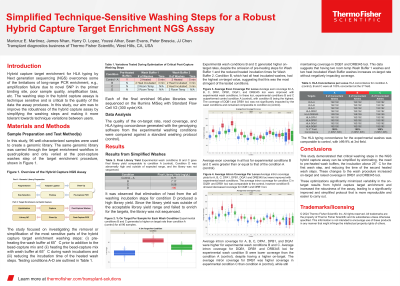Back

Simplified Technique Sensitive Washing Steps for a Robust Hybrid Capture Target Enrichment NGS Assay
(P106) Simplified technique sensitive washing steps for a robust hybrid capture target enrichment NGS assay
Location: Platinum Ballroom

Poster Presenter(s)
Aim: Using hybrid capture target enrichment for HLA typing by Next generation sequencing (NGS) overcomes some of the limitations of long-range PCR enrichment, e.g. amplification failure due to novel SNP in the primer binding site, or poor sample quality, etc. The washing step in the hybrid capture assays is technique sensitive and is critical to the quality of the data the assay produces. In this study, our aim was to improve the robustness of hybrid capture assay by simplifying the washing steps and making it more tolerant towards technique variations between users.
Method: In a standard hybrid capture target enrichment NGS assay, there are typically four washing steps. The study focused on investigating the removal or simplification of the most sensitive parts of the washing steps: (a) pre-heating the wash buffer at 65°C prior to addition to the bead-capture mix and (b) heating the bead-capture mix with wash buffer at 65°C during wash incubations. The quality of the sequencing metrics, on-target rate, read coverage, and HLA typing concordance from the modified washing workflows were compared against the control (standard washing protocol).
Results: Omitting the preheating step for the wash buffers had no effect on sequencing metrics, on-target rate, and coverage metrics when compared to control. Testing revealed that there were no effects on measured metrics when the initial two wash incubations were omitted. However, it was observed that elimination of heat from the last two washing incubation steps produced lower on-target rates when compared to the control. Interestingly the time of the incubations could be reduced without affecting measured metrics. The HLA typing concordance for modified washes was comparable to control, with ≥99.9% at 3rd field.
Conclusion: This study demonstrated that critical washing steps in the NGS hybrid capture assay can be simplified by eliminating: (a) the need to pre-heat wash buffers and (b) the incubation above 25°C for the first wash step. Along with reducing the time of the second heated wash step, this significantly minimizes variability in the on-target results from hybrid capture target enrichment, leading to a significantly improved and simplified protocol that is more reproducible and easier to carry out.
Method: In a standard hybrid capture target enrichment NGS assay, there are typically four washing steps. The study focused on investigating the removal or simplification of the most sensitive parts of the washing steps: (a) pre-heating the wash buffer at 65°C prior to addition to the bead-capture mix and (b) heating the bead-capture mix with wash buffer at 65°C during wash incubations. The quality of the sequencing metrics, on-target rate, read coverage, and HLA typing concordance from the modified washing workflows were compared against the control (standard washing protocol).
Results: Omitting the preheating step for the wash buffers had no effect on sequencing metrics, on-target rate, and coverage metrics when compared to control. Testing revealed that there were no effects on measured metrics when the initial two wash incubations were omitted. However, it was observed that elimination of heat from the last two washing incubation steps produced lower on-target rates when compared to the control. Interestingly the time of the incubations could be reduced without affecting measured metrics. The HLA typing concordance for modified washes was comparable to control, with ≥99.9% at 3rd field.
Conclusion: This study demonstrated that critical washing steps in the NGS hybrid capture assay can be simplified by eliminating: (a) the need to pre-heat wash buffers and (b) the incubation above 25°C for the first wash step. Along with reducing the time of the second heated wash step, this significantly minimizes variability in the on-target results from hybrid capture target enrichment, leading to a significantly improved and simplified protocol that is more reproducible and easier to carry out.

